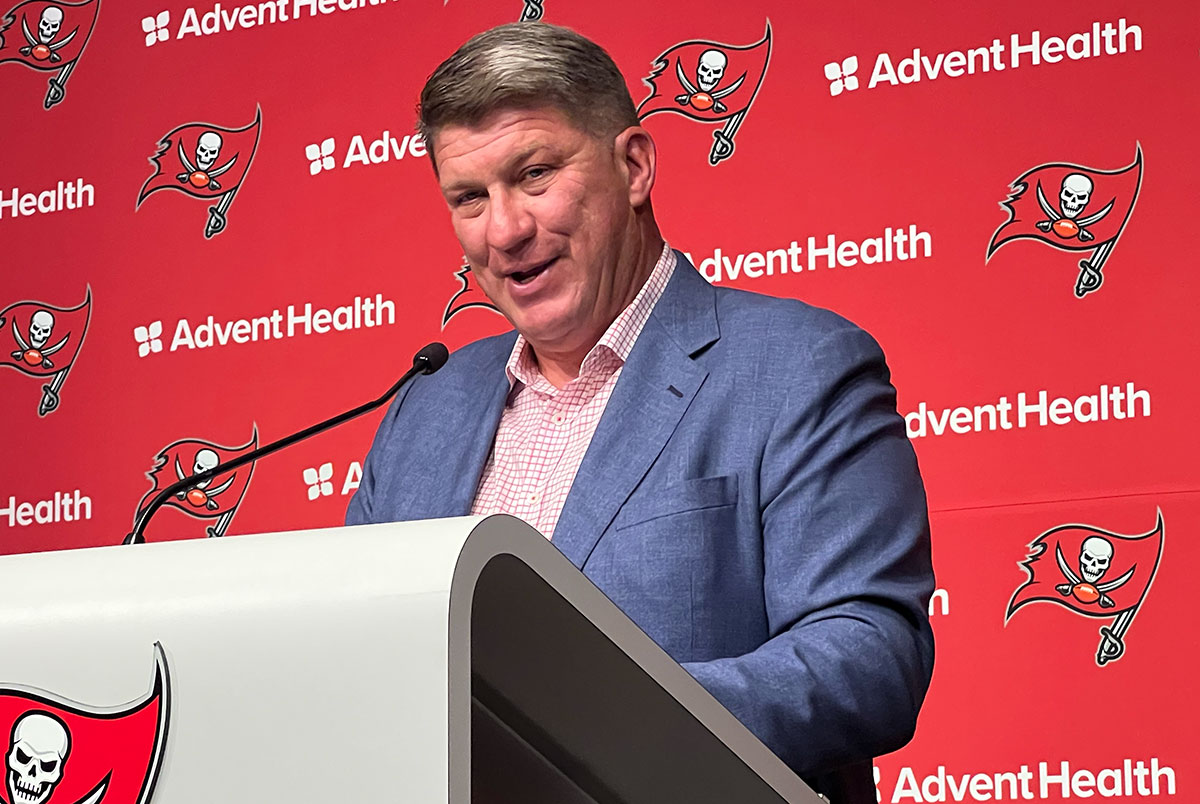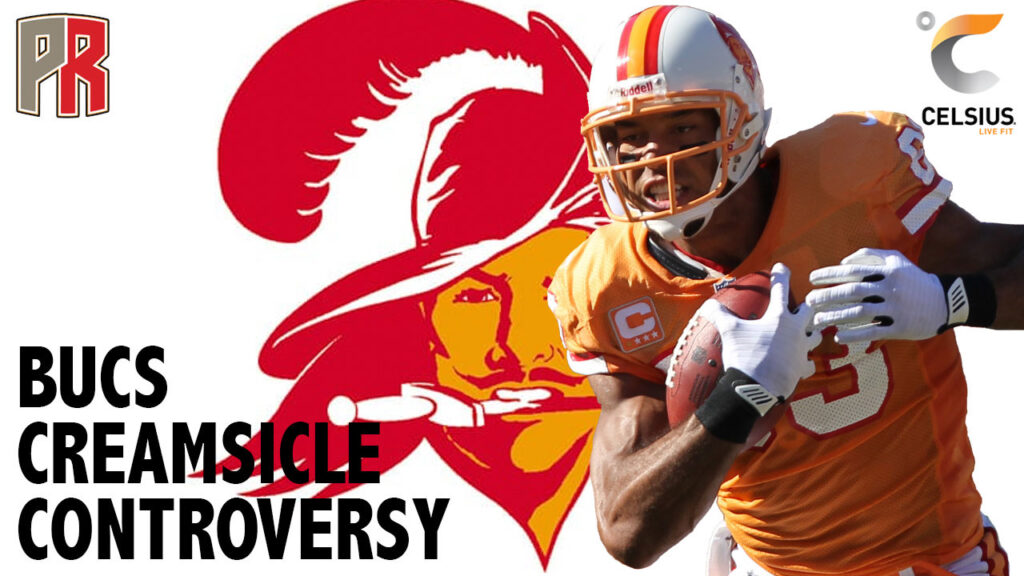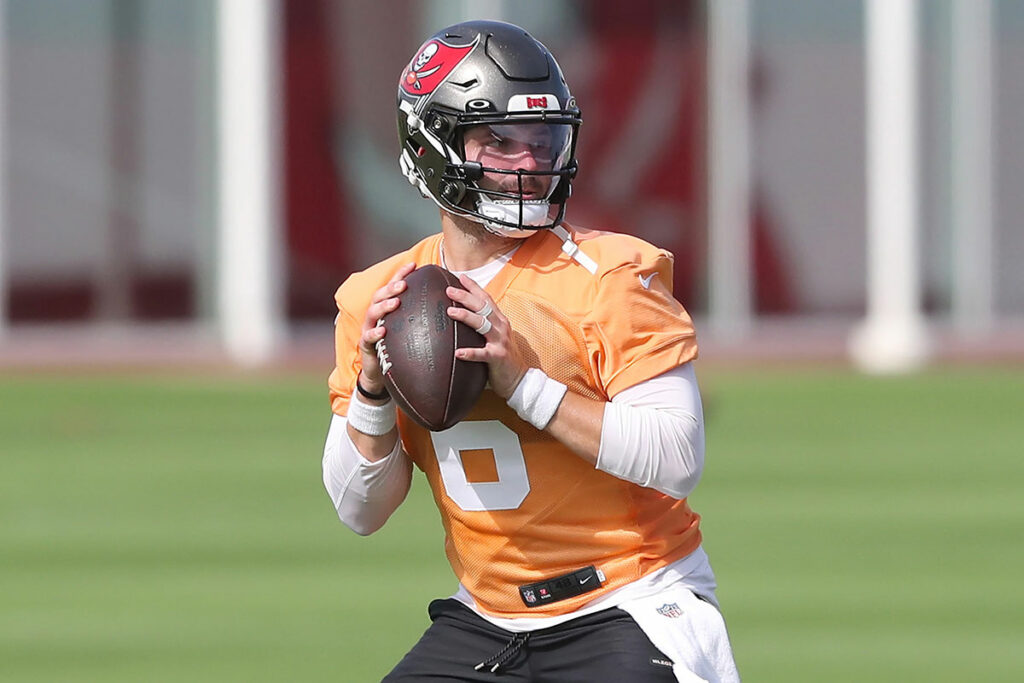The Bucs have had to navigate troubled waters this offseason by supplementing a roster that, just two seasons ago, would be celebrating a Super Bowl victory at Raymond James Stadium.
Time flies.
Having to thread the needle between competing and retooling, the Bucs have done well to bring in players with upside on affordable deals through “Moneyball” tactics. The team did their best to bring in their own versions of David Justice, Chad Bradford, Jeremy Giambi, and Scott Hatteberg.
That is not to mention retaining two key free agents that could have left for other teams with a better chance to contend. While Pewter Report has covered and analyzed the Bucs’ draft class in detail, what about free agency?
Did the team have the best offseason given their circumstances, and did they get the best bang for their “Buc?” Compared to the rest of the league’s signings, there is a lot of reason to believe so. All contract terms used below were pulled from spotrac.com.
Bucs Outside Signings Provide Surplus Value
Quarterback Baker Mayfield: One Year, $4 Million
- Derek Carr (Saints): Four years, $150 million
- Jimmy Garappolo (Raiders): Three years, $72.75 million
- Taylor Heinicke (Falcons): Two years, $14 million
- Jarrett Stidham (Broncos): Two years, $10 million
- Andy Dalton (Panthers): Two years, $10 million
- Jacoby Brissett (Commanders): One year, $8 million
- Marcus Mariota (Eagles): One year, $5 million
- Sam Darnold (49ers): One year, $4.5 million
- Mike White (Dolphins): Two years, $8 million
- Drew Lock (Seahawks): One year, $4 million
There were 10 quarterbacks signed during this cycle of free agency who signed contract terms of greater or equal value than that of Baker Mayfield. Of all the options above, Mayfield has the most upside and chance to make his deal a bargain.
Each of the teams within the NFC South brought in a veteran quarterback, but at what cost?
The Saints guaranteed Derek Carr $60 million dollars to be their franchise signal-caller, and he is coming off his worst season since his rookie year. He was benched for another guy on this list (Jarrett Stidham) and left the team before the end of the season. In terms of finances, the Bucs signing the former first-overall pick for $4 million looks a lot better.
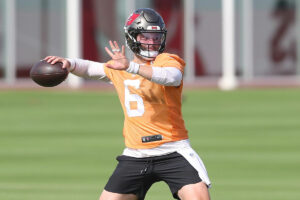
Bucs QB Baker Mayfield – Photo by: Cliff Welch/PR
Between Mayfield and Carr, Mayfield is four years younger and has the best season (by QBR) in comparing their respective careers. Carr has been more consistent, but Mayfield has had to deal with more dysfunction and situations outside his control. That is no excuse for his uneven play, but it also allowed Tampa Bay to get him for pennies on the dollar. Everything is in place for him to “feel dangerous” and revive his career at the best price point.
Other NFC South quarterback signings (Taylor Heinicke and Andy Dalton) were in Mayfield’s ballpark in financial terms, but both are also safer, lower-ceiling choices. Heinicke has the poise and leadership qualities to rival him, but he has only started for the majority of two seasons with uninspiring numbers. He is a game manager, while Dalton is approaching the proverbial cliff.
At 35, he is going to be mentoring Bryce Young in Carolina while being paid like a top backup. He re-emerged last season in New Orleans after looking the part of an average quarterback for the past few years.
Outside of the division, the other quarterbacks signing around the $4-5 million mark either lack the track record or run of success that Mayfield has. Lock (21), White (7), and Stidham (2) all have far fewer starts than his 69, while former top picks Mariota and Darnold have flamed out comparatively quicker with less reason to be optimistic about them having a career turnaround.
Baker Mayfield is debatably one of the best quarterbacks in the above group, but there is no debating that — at just $4 million in guarantees and his comparative upside — he has been the best free-agent quarterback signing in the NFL.
Defensive Tackle Greg Gaines: One Year, $3.5 Million
- Javon Hargrave (49ers): Four years, $84 million
- Dalvin Tomlinson (Browns): Four years, $57 million
- David Onyemata (Falcons): Three years, $35 million
- Fletcher Cox (Eagles): One year, $10 million
- Sheldon Rankins (Texans): One year, $9.75 million
- Shy Tuttle (Panthers): Three years, $19.5 million
- Khalen Saunders (Saints): Three years, $12.3 million
- Rakeem Nunez-Roches (Giants): Three years, $12 million
- Quinton Jefferson (Jets): One year, $3.6 million
- Taven Bryan (Colts): One year, $3.51 million
The Bucs swapped out Rakeem Nunez-Roches for Greg Gaines. While there is no replacing the energy and personality of “Nacho,” the team “gained” more production at a lower cost.
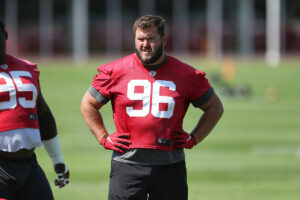
Bucs DT Greg Gaines – Photo by: Cliff Welch/PR
Nunez-Roches had a career year in 2022 which he parlayed into a three-year deal with the Giants, but Gaines is coming off consecutive seasons of solid play. In 2021 alone, he recorded 55 total tackles, 13 quarterback hits, and 4.5 sacks.
With Tampa Bay expecting big things from Calijah Kancey and Logan Hall, Gaines will likely come in games to replace Vita Vea and to help be a run-stuffer. It is hard to argue the Bucs made the most of their funds to bring him in.
There is no arguing there were some better albeit pricier options in Javon Hargrave, Dalvin Tomlinson, Fletcher Cox, and Sheldon Rankins. But Gaines compares well to David Onyemata (Falcons) and Shy Tuttle (Panthers), who each became well-compensated from division rivals.
Here is a quick comparison of how each played in 2022:
David Onyemata: 64.0 PFF grade, 43 total tackles, 11 quarterback hits, five sacks
Shy Tuttle: 60.3 PFF grade, 49 total tackles, three quarterback hits, two sacks
Greg Gaines: 59.1 PFF grade, 36 total tackles, six quarterback hits, four sacks
At a quarter and half of their respective annual contract values, credit should go to Bucs general manager Jason Licht and the front office for adding a solid interior defensive lineman at a time when many are starting to get massive deals across the NFL.
Strong Safety Ryan Neal: One Year, $1.23 Million
- Vonn Bell (Panthers): Three years, $22.5 million
- Kareem Jackson (Broncos): One year, $2.66 million
- Keanu Neal (Steelers): Two years, $4.25 million
- Dean Marlowe (Bills): One year, $1.23 million
Last but not least, the secondary was bolstered by the addition of Ryan Neal. It is not a secret that down the stretch last season, Neal graded out as one of the league’s best safeties.
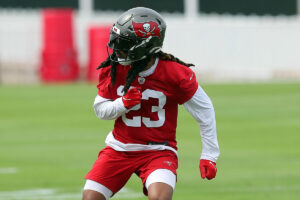
Bucs S Ryan Neal – Photo by: Cliff Welch/PR
His signing is the definition of a prove-it deal, as if he shows 2022 was not a fluke; he will get a larger payday. But for now, playing on a minimum deal is a big win for the Bucs in free agency. There is more to like in him than Keanu Neal, who departed to the Steelers.
Vonn Bell is no slouch and returns to the NFC South after playing an integral part for the Bengals for the past three seasons. But comparing Neal to Bell, Neal graded out higher by PFF (82 to 69.3), and his $1.23 million deal is 16.4% of the $7.5 million average doled out to Bell. Marlowe, the other safety who signed on a minimum deal, was a reserve for the Falcons and Bills and had 14 tackles in 12 games.
Bringing in Neal was a steal and an “A” grade free agent signing. In Todd Bowles’ defense, he will have every opportunity to star.
Bucs Did Well In Re-Signing Their Own
Inside Linebacker Lavonte David: One Year, $4.5 million
- Tremaine Edmunds (Bears): Four years, $72 million
- Eric Kendricks (Chargers): Two years, $13.25 million
- Alex Anzalone (Lions): Three years, $18.3 million
- Bobby Wagner (Seahawks): One year, $5.5 million
The Bears paid Tremaine Edmunds handsomely compared to the rest of those listed, and he is the anomaly here. He also just turned 25 while the others, Lavonte David included, are in their 30s or closer to it in Anzalone’s case.

Bucs ILB Lavonte David – Photo by: Cliff Welch/PR
Of the five inside linebackers, the Bucs bringing back David at just $4.5 million is a great value. His closest comparison is Bobby Wagner, who is slightly more productive and took a similar pay cut to return to Seattle.
There was a lot of talk that David would leave for a playoff contender, such as the Bills, but he chose to stick around and continue being a lifetime Buccaneer. He was the league’s third-graded linebacker per PFF (Wagner was first), while Edmunds was fifth.
At a time when young players get paid for their upside, some veterans take a discount to remain where they are valued. It is hard to argue a franchise values a player more than Tampa Bay does with Lavonte David, and that feeling is mutual. His performance alone was worth double what he received, and that does not mention his priceless status as a captain and leader.
Cornerback Jamel Dean: Four Years, $52 Million
- James Bradberry (Eagles): Three years, $38 million
- Cameron Sutton (Lions): Three years, $33 million
Bucs fans, don’t make a scene that Jamel Dean returned. It was a seemingly foregone conclusion that he was going to leave in free agency after demonstrating his worth and playing his way into Top 10 cornerback status. While he was projected to get a contract in the $17-18 million range, he surprisingly re-signed at a $13 million annual average.
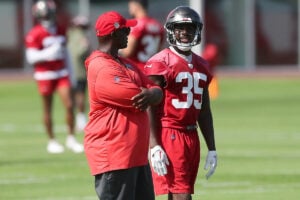
Bucs head coach Todd Bowles and CB Jamel Dean – Photo by: USA Today
Considering there was a chance that he would be the highest-paid cornerback in free agency, Dean proved his loyalty to the team and secondary partner Carlton Davis III by returning on a favorable deal.
The only other cornerbacks to sign deals in his range were James Bradberry and Cameron Sutton. Both also entered more favorable situations, with Bradberry returning to the Super Bowl runner-up and Sutton on an up-and-coming team. For the Bucs to retain a top cornerback when they are at a premium is one thing. They also did so as a team in transition.
Of course, each of these five signings are not all of the moves the team has made. An honorable mention goes out to running back Chase Edmonds, who signed on the league minimum. There have also been numerous undrafted free agent signings and re-signings of other players. But each of these moves asserts that the Bucs constructed the best product within the confines of their limited cap room.
Adam Slivon has covered the Bucs for four seasons with PewterReport.com as a Bucs Beat Writer, Social Media Manager, and Podcaster. Adam started as an intern during his time at the University of Tampa, where he graduated with a degree in Sport Management in May 2023.
In addition to his regular written content, he appears every Thursday on the Pewter Report Podcast, has a weekly YouTube Top 10 Takeaways video series, and leads the managing of the site's social media platforms.
As a Wisconsin native, he spent his childhood growing up on a farm and enjoys Culver's, kringle, and a quality game of cornhole. You can find him most often on X @AdamLivsOn.

